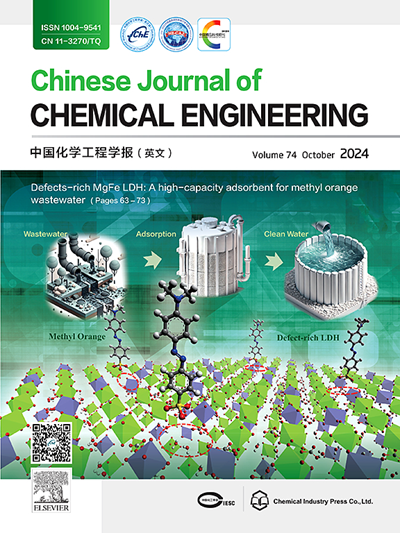Nitrogen-doped composite aerogels from ZIF-8 derived porous carbon and chitosan for CO2 adsorption
IF 3.7
3区 工程技术
Q2 ENGINEERING, CHEMICAL
引用次数: 0
Abstract
It is well known that adsorbent material is the key to determine the CO2 adsorption performance. Herein, ZIF-8 derived porous carbon (ZIF-8-C) is anchored into the framework of a novel composite aerogel (ZCPx), which utilizes chitosan (CS) and polyvinyl alcohol (PVA) as raw materials. By controlling the ratio of ZIF-8-C, the developed hierarchical porous structures combine the advantages of micropores, mesopores, and macropores. Besides, the ligand material of ZIF-8-C and the amino group from CS are two sources of the high nitrogen content of ZCPx. The optimized sample ZCP4 shows a high nitrogen content of 6.78%, which can create more active centers and supply basic sites, thereby enhancing the CO2 adsorption capacity. Moreover, ZCP4 composite aerogel presents a CO2 adsorption capacity of 2.26 mmol·g−1 (298 K, 1 bar (equivalent to 100 kPa)) and CO2/N2 selectivity () can reach 20.02, and the dynamic breakthrough experiment is performed to confirm the feasibility of CO2/N2 actual separation performance, proving that the composite aerogel is potential candidates for CO2 adsorption.

氮掺杂复合气凝胶由ZIF-8衍生多孔碳和壳聚糖用于CO2吸附
众所周知,吸附剂材料是决定CO2吸附性能的关键。本文将ZIF-8衍生的多孔碳(ZIF-8- c)固定在以壳聚糖(CS)和聚乙烯醇(PVA)为原料的新型复合气凝胶(ZCPx)的框架中。通过控制ZIF-8-C的比例,形成了集微孔、中孔和大孔优点于一体的层次化多孔结构。此外,ZIF-8-C的配体材料和CS的氨基是ZCPx高氮含量的两个来源。优化后的ZCP4样品含氮量高达6.78%,可以产生更多的活性中心和提供碱性位点,从而提高CO2吸附能力。此外,ZCP4复合气凝胶的CO2吸附量为2.26 mmol·g−1 (298 K, 1 bar(相当于100 kPa)), CO2/N2选择性(SCO2/N2)可达20.02,并进行了动态突破实验,验证了CO2/N2实际分离性能的可行性,证明了复合气凝胶是CO2吸附的潜在候选材料。
本文章由计算机程序翻译,如有差异,请以英文原文为准。
求助全文
约1分钟内获得全文
求助全文
来源期刊

Chinese Journal of Chemical Engineering
工程技术-工程:化工
CiteScore
6.60
自引率
5.30%
发文量
4309
审稿时长
31 days
期刊介绍:
The Chinese Journal of Chemical Engineering (Monthly, started in 1982) is the official journal of the Chemical Industry and Engineering Society of China and published by the Chemical Industry Press Co. Ltd. The aim of the journal is to develop the international exchange of scientific and technical information in the field of chemical engineering. It publishes original research papers that cover the major advancements and achievements in chemical engineering in China as well as some articles from overseas contributors.
The topics of journal include chemical engineering, chemical technology, biochemical engineering, energy and environmental engineering and other relevant fields. Papers are published on the basis of their relevance to theoretical research, practical application or potential uses in the industry as Research Papers, Communications, Reviews and Perspectives. Prominent domestic and overseas chemical experts and scholars have been invited to form an International Advisory Board and the Editorial Committee. It enjoys recognition among Chinese academia and industry as a reliable source of information of what is going on in chemical engineering research, both domestic and abroad.
 求助内容:
求助内容: 应助结果提醒方式:
应助结果提醒方式:


